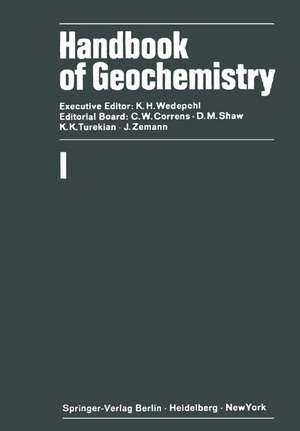Handbook of Geochemistry: Handbook of Geochemistry, cartea 1
Autor K. H. Wedepohlen Limba Engleză Paperback – 9 mar 2012
Preț: 737.74 lei
Preț vechi: 899.68 lei
-18% Nou
Puncte Express: 1107
Preț estimativ în valută:
141.21€ • 153.44$ • 118.69£
141.21€ • 153.44$ • 118.69£
Carte tipărită la comandă
Livrare economică 21 aprilie-05 mai
Preluare comenzi: 021 569.72.76
Specificații
ISBN-13: 9783642463020
ISBN-10: 3642463029
Pagini: 464
Ilustrații: XVI, 442 p.
Dimensiuni: 170 x 244 x 30 mm
Greutate: 0.74 kg
Ediția:1969
Editura: Springer Berlin, Heidelberg
Colecția Springer
Seria Handbook of Geochemistry
Locul publicării:Berlin, Heidelberg, Germany
ISBN-10: 3642463029
Pagini: 464
Ilustrații: XVI, 442 p.
Dimensiuni: 170 x 244 x 30 mm
Greutate: 0.74 kg
Ediția:1969
Editura: Springer Berlin, Heidelberg
Colecția Springer
Seria Handbook of Geochemistry
Locul publicării:Berlin, Heidelberg, Germany
Public țintă
ResearchCuprins
1 The Discovery of the Chemical Elements. The History of Geochemistry. Definitions of Geochemistry.- I. The Discovery of the Chemical Elements.- II. The History of Geochemistry.- III. Definitions of Geochemistry.- References.- 2 Crystal Chemistry.- References.- 3 Thermodynamics Used in Geochemistry.- Symbols.- References.- 4 Meteorite Composition.- I. Introduction.- II. Meteorite Classification.- III. Chemical Composition of Meteorites.- IV. Mineralogical Composition of Meteorites.- References.- 5 Cosmic Abundances.- I. Introduction.- II. Cosmic Abundances.- III. The Bulk Composition of the Earth.- IV. Other Applications of Cosmic Abundances.- References.- 6 Geophysical Aspects of Structure and Composition of the Earth and the Earth Crust.- Principal Subdivision of the Earth’s Interior.- Symbols.- References.- 7 Composition and Abundance of Common Igeneous Rocks.- I. Nomenclature of Igneous (Magmatic) Rocks.- II. Chemical Composition of Common Igneous Rocks.- III. Rock Nomenclature and Current Trends in Igneous Petrology.- IV. Abundance of Common Intrusive Rocks.- V. Abundance of Common Volcanic Rocks.- VI. Average Composition of the Upper Continental Earth’s Crust.- References.- 8 Composition and Abundance of Common Sedimentary Rocks.- I. Nomenclature of Sedimentary Rocks.- II. Average Composition of Common Sedimentary Rocks.- III. Rock Nomenclature and Current Trends in Sedimentary Petrology.- IV. Abundance of Common Sediments and Sedimentary Rocks.- References.- 9 Composition and Abundance of Common Metamorphic Rock Types.- I. General Trends in Metamorphism.- II. Isochemical Series of Metamorphism.- III. Allochemical Series of Metamorphism (Metasomatism).- IV. Contact Metamorphism.- V. Migmatites, Anatexis, Granitization.- References.- 10 The Oceans, Streams, andAtmosphere.- I. The Oceans.- II. Streams.- III. The Atmosphere.- References.- 11 Evaluation of Data.- I. Analytical Errors and Related Topics in Geochemistry.- II. Statistical Procedures.- III. Interpretation of Chemical Analysis of Silicates.- References.- 12 Tables.- 1. Physical Constants.- 2. Periodic System.- 3. Table of Relative Atomic Weights.- 4. Table of Isotopic Abundance and Relative Atomic Weights.- 5. Naturally Occurring Radioactive Elements.- 6. Electronic Configuration of the Elements in Their Normal States.- 7. The Effective Radii of Atoms.- 8. Table of the Effective Radii of Ions.- 9. Ionization Potentials for Elements in the Atomic State.- 10. Electronegativity Values.- 11. Molar Volumes and Densities of Minerals.- 12. The Theoretical Composition of Some Silicate Minerals in Cation Percentage.- 13. The Theoretical Composition of Some Silicate Minerals in Weight Percentage.- 14. The Theoretical Composition of Some Non-silicate Minerals in Weight Percentage.- 15. The Theoretical Composition of Some Ore Minerals in Weight Percentage.- 16. Astronomical Constants.- 17. Solar Dimensions.- 18. Dimensions of the Planets and the Moon.- 19. Earth’s Dimensions.- 20. Earth’s Interior, Masses and Dimensions of the Principle Subdivisions.- 21. The Surface Areas of the Earth.- 22. Geological Time-scales.- 23. Measures, Units and Conversion Factors.- References.- Author Index.













